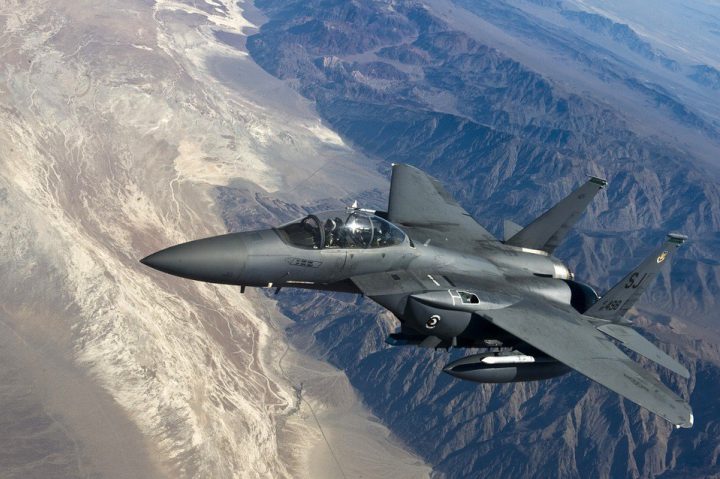Climate change and security
Why are generals and admirals increasingly concerned about climate change?

By Richard Black
@_richardblackShare
Last updated:
Words of warning
Asked in 2013 what was the most significant long-term security threat in the Pacific region, Admiral Samuel J Locklear III, head of the US Pacific Command, answered: ‘climate change’. Among other things, Admiral Locklear is responsible for monitoring the North Korean nuclear situation and ongoing hostilities between China and Japan over islands that both nations claim.
Sea level rise and more extreme weather, he said, could ‘cripple the security environment, probably more likely than the other scenarios we all often talk about’.

In October 2014, alongside the launch of the US Department of Defense 'Adaptation Roadmap', then Defense Secretary Chuck Hagel confirmed that officials were preparing plans to cope with projected sea-level rise of around 1.5 feet (45cm) in the next 20-50 years. The US Defense Secretary has also warned that while terrorism poses an immediate threat, climate change poses one of the biggest long-term security threats.
In November 2015, a British Government report identifying key threats to the UK found ‘more frequent extreme weather events are likely to disrupt populations, agriculture and supply chains, making political instability, conflict and migration more likely’.
Climate change in national security strategies
The UK’s 2015 National Security Strategy agrees that a changing climate is likely to make political instability, conflict and migration more likely. The strategy sets out climate change as one of two major global risk areas that threaten stability overseas and in which the UK has chosen to invest, increasing climate finance for developing countries by at least 50% over five years.
In September 2016 a US Presidential memorandum directed federal departments and agencies to fully integrate climate change and its impacts into national security policy. The memorandum warned that climate change and its associated impacts could affect the US military’s readiness, facilities and training, while increasing demands for support for international stability and humanitarian missions.
How does climate change increase security risks?
The origins of conflict are complex, and it is unlikely that climate change will be a direct or sole cause. But the 2014 assessment from the Intergovernmental Panel on Climate Change (IPCC), the UN body responsible for collating scientific evidence on the issue, concludes that climate change impacts have the potential to exacerbate factors linked to conflict in some regions of the world. The UK Committee on Climate Change echoed these warnings in its national risk assessment.
Climate change impacts either identified or projected for various regions of the world include increases in extreme weather events, disruption to food and water supplies, the spread of disease, and migration. In many regions, the IPCC says that food production is likely to fall in future decades, with lower yields from major crops including wheat, maize and rice projected. It also concludes that each degree (Celsius) of warming is likely to decrease renewable water resources by at least 20% for an additional 7% of the global population. Projected longer-term changes include a reduction in glacier meltwater.
Loss of land and livelihood, disease and dwindling access to food and water can cause humanitarian crises, and force people from their homes, increasing the risk of instability. This is especially so in parts of the world already experiencing stresses such as food and water shortages, poor health or recent conflict. Poor societies with limited capacity to adapt are likely to be worst affected.
Some impacts of climate change may have consequences far from their source. For example, the 2010 heatwave in Russia, which was made more likely by climate change, compromised the wheat harvest. The Russian government accordingly banned exports, increasing grain prices across the world. High grain prices have regularly been a contributory factor to unrest in the Middle East, including that leading to the Arab Spring.

Global hotspots
Impacts of climate change are being felt across the world. But the difference they make to people’s lives will vary hugely between regions. Societies in Polar regions and the Equatorial belt are particularly vulnerable.
According to the UK Ministry of Defence, in sub-Saharan Africa, the combined challenge of an increased population, demands on resources and the effects of climate change (particularly drought) on food and water supplies are likely to lead to tension, which could result in conflict.
There is evidence implicating a severe three-year drought in Syria, which was made two to three times more likely by climate change, in the Syrian uprising. The drought led to crop failures, resulting in mass migration to urban centres which, it is suggested, contributed to political unrest.
A large proportion of Asia’s population lives on low-lying land along the coast that is particularly at risk from sea level rise, storm surges and typhoons. There are also concerns that tensions will increase due to climate-driven water variability in the trans-boundary drainage systems linked to the vast Tibetan Plateau in central Asia, whose rivers supply more than one billion people with water.
Direct impacts on the military
The US Government Accountability Office (GAO) in 2014 said that climate-linked problems including rising sea levels and thawing permafrost are already affecting military bases. The world’s largest naval base at Norfolk, Virginia is making plans to cope with a two-foot (60cm) rise in sea level over the next 35 years.
Military forces are often called into play during humanitarian crises. The UK’s Ministry of Defence warns that climate change may raise the frequency with which such interventions are needed, with implications for resources.
